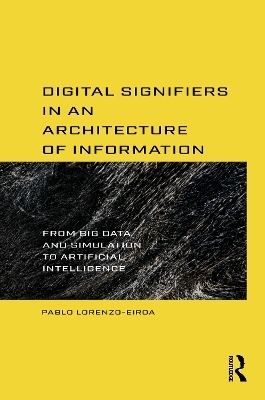
Digital Signifiers in an Architecture of Information
Routledge (Verlag)
978-1-032-27270-2 (ISBN)
- Titel z.Zt. nicht lieferbar
- Versandkostenfrei innerhalb Deutschlands
- Auch auf Rechnung
- Verfügbarkeit in der Filiale vor Ort prüfen
- Artikel merken
Historically, architecture has led to spatial representation. Today, computation has established new representational paradigms that can be compared to spatial representations, such as the revolution of perspective in the Renaissance. Architects now use software, robotics, and fabrication tools with very little understanding and participation in how these tools influence, revolutionize, and determine both architecture and its construction today. Why does the discipline of architecture not have a higher degree of authorship in the conception and development of computational technologies that define spatial representation? This book critically explores the relationship between history, theory, and cultural criticism. Lorenzo-Eiroa positions new understandings through parallel historical sections and theories of many revolutionary representational architecture canons displaced by conventional spatial projection. He identifies the architects, artists, mathematicians, and philosophers that were able to revolutionize their disciplines through the development of new technologies, new systems of representation, and new lenses to understand reality. This book frames the discussion by addressing new means to understand and expand architecture authorship in relation to the survey, information, representation, higher dimensional space, Big Data, and Artificial Intelligence – in the pursuit of activating an architecture of information.
This will be important reading for upper-level students and researchers of architecture and architectural theory, especially those with a keen interest in computational design and robotic fabrication.
Pablo Lorenzo-Eiroa is the Founder of e-Architects.net, Director of the AI Lab, and Associate Professor at the New York Institute of Technology School of Architecture and Design. He co-edited Architecture In:Formation, Routledge, 2013.
Introduction 1.SYSTEMS OF MEASUREMENT IDEALIZING AND DISPLACING HUMAN PROPORTIONS 2. BRUNELLESCHI’S PARAMETRIC ANALOG COMPUTATIONAL INTERFACE: FROM A NEW MEDIA NORMALIZING VISUALIZATION TO INDEXING, DISPLACING, AND INNOVATING IN REPRESENTATIO 3. PALLADIO’S PARAMETRIC UNDECIDABILITY AS A CRITICAL TOPOLOGICAL MODEL 4. BORROMINI'S TOPOLOGICAL MODEL DISPLACED BY RAINALDI’s AHISTORICAL SYNTHESIS: ARCHITECTS INDEXING, DISPLACING, AND INNOVATING IN SPATIAL REPRESENTATION 5. LINGUISTIC AND VISUAL SEMIOTICS SIGNS AS SIGNIFIERS ANTICIPATING AUTHORSHIP IN ARCHITECTURE 6. COMPUTATIONAL LINGUISTIC SEMIOTICS: FROM MATHEMATICS, TO COMPUTATIONAL LANGUAGES GRAMMAR, TO MACHINE LEARNING, TO SIGNIFIEDS IN NATURAL LANGUAGE PROCESSING (NLP), TO EMERGENT PROGRAMMING 7. COMPUTATIONAL VISUAL SEMIOTICS: GRAMMATOLOGY DISPLACING SIGNALS, SIGNS AND DIGITAL SIGNIFIERS FROM PIXELS TO POINT CLOUDS AND PARTICLES ACTIVATING EMERGENT PROGRAMMING 8. DISPLACING ARTIFICIAL ORIGINATION BY DIGITAL SIGNIFIERS FROM COMPUTATION TO AI 9. EXPANDING DIMENSIONS IN SPATIAL REFERENCE AND REPRESENTATIONAL SYSTEMS TOWARDS A MULTIDIMENSIONAL ARCHITECTURE OF INFORMATION: FROM TOPOLOGY, TO ARTIFICIAL NEURAL NETWORKS, TO QUANTUM COMPUTING 10. COMPUTATIONAL INFORMATIONAL SEMIOTICS: SIGNS AND SIGNALS IN MACHINES TO "DRAW" AND "BUILD" THROUGH DOUBLE BIND ADVERSARIAL ROBOTIC FEEDBACK ACTUALIZATION 11. GAUDI’S ANALOG COMPUTATIONAL MODEL AS BACKPROPAGATION: FROM MATHEMATICAL MODELLING, TO BIG DATA SURVEY, TO SIMULATION, TO AI 12. AI EMERGENT STRUCTURE THROUGH ROBOTIC SIGNALS AS INFORMATION ACTUALIZATION 13. AI SYNTHETIC ENVIRONMENTS AS SIMULATION-BASED INFORMATION ACTUALIZATION 14. POST-HUMAN PROJECT-SPECIFIC AND SITE-SPECIFIC ROBOTIC SYSTEM 15. DECONSTRUCTING THE CITY THROUGH NEW SIGNIFIERS: SIMULATION-BASED EMERGENT SPACE-ENVIRONMENTS 16. BIG DATA POLITICS IN EMERGENT SPACE-ENVIRONMENTS: REZONING NEW YORK CITY THROUGH BIG DATA, AI, and SIMULATION 17. THERMODYNAMIC BLOCKCHAIN ENVIRONMENTAL ENGINE: TOWARDS POST-CAPITALIST UNIVERSAL SPACE-ENVIRONMENTS 18. BIG DATA REALISM AND AI ABSTRACTION: POST-COLONIAL EMERGENT HISTORIES IN AUGMENTED SYNTHETIC UNREAL ENVIRONMENTS 19. BIG DATA AI SIMULACRA WITHIN A REPRESENTATION RESTRICTED REALITY (RRR): FROM PIRANESI’S AHISTORIC ARCHEOLOGY, TO AN URBANISM OF INFORMATION, TO A QUANTUM "AI" SIMULACRA 20. CONCLUSION: EXPANDING AUTHORSHIP THROUGH an AHISTORIC CRITICAL ARCHITECTURE OF INFORMATION AI
| Erscheinungsdatum | 17.07.2023 |
|---|---|
| Zusatzinfo | 150 Halftones, black and white; 150 Illustrations, black and white |
| Verlagsort | London |
| Sprache | englisch |
| Maße | 156 x 234 mm |
| Gewicht | 1020 g |
| Themenwelt | Informatik ► Theorie / Studium ► Künstliche Intelligenz / Robotik |
| Naturwissenschaften ► Biologie ► Ökologie / Naturschutz | |
| Naturwissenschaften ► Geowissenschaften ► Geografie / Kartografie | |
| Technik ► Architektur | |
| ISBN-10 | 1-032-27270-8 / 1032272708 |
| ISBN-13 | 978-1-032-27270-2 / 9781032272702 |
| Zustand | Neuware |
| Informationen gemäß Produktsicherheitsverordnung (GPSR) | |
| Haben Sie eine Frage zum Produkt? |
aus dem Bereich


